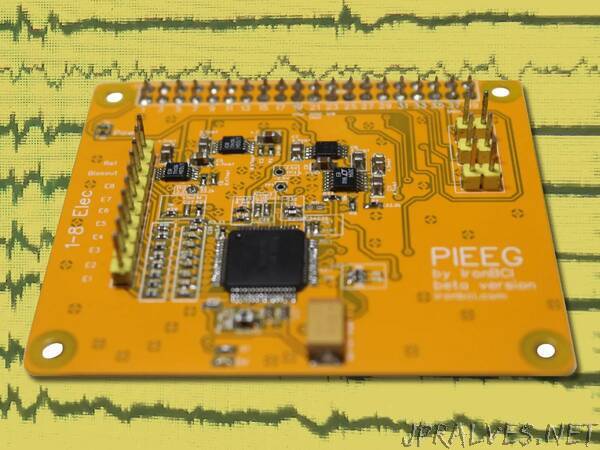
“Brain-computer interfaces, or BCIs, are having a bit of a moment: Big tech companies have invested in the development of these neurotechnologies—designed to connect brains to digital machinery—specifically making substantiveacquisitions of EEG-based neurotechnology startups in recent years. Even companies like BlackRock Neurotech, Neuralink, and Synchron, which are developing surgically implanted BCI systems, are starting to break into the medical-device market, having raised a combined US $423 million to develop interfaces as medical devices as of 2021.
These investments might, one day, put devices either into or onto some people’s heads. However, the science they’re built on—decoding cognitive processes into usable control signals for computer systems—has been done successfully in academic labs for decades. The mathematics and programming involved are likely not beyond the grasp of many engineers, but the required hardware has so far been prohibitively expensive for the casual DIYer. With electrodes and amplifiers easily running up into the tens or hundreds of thousands of dollars, homebrew neurotech has remained, until recently, out of grasp for many.
The board is designed to easily snap onto the Raspberry Pi, creating an easily accessible, all-in-one brain-computer interface (BCI) development platform.
Now, however, open-source neural hardware and software development is appearing in the market alongside higher-profile hardware from far more well-resourced big tech firms. PiEEG, designed by Ildar Rakhmatulin, BCI researcher at Edinburgh’s Heriot-Watt University, is an EEG acquisition board currently available on the crowd-funding website Crowd Supply for $250. The board is designed to easily snap onto the similarly low-cost and open-source Raspberry Pi computer, creating an easily accessible, all-in-one BCI development platform.
Rakhmatulin got started with open-source neuroscience hardware when he became interested in using machine-learning methods within BCI systems but could not find suitable hardware to experiment with. “I wanted to use hardware that was already available, but did not find any low-cost or comfortable devices on the market,” said Rakhmatulin. After spending some time teaching himself the basics and working with colleagues at Heriot-Watt, he developed ironbci, a biosignal acquisition platform for electroencephalogram (EEG), electrocardiogram (ECG), or electromyogram (EMG) data.
The ironbci platform was a functional success, but device development was severely hindered by the worldwide chip shortages caused by the global COVID-19 pandemic’s effect on electronics production and supply chains. Without the ability to source the chips needed for the system, Rakhmatulin couldn’t build them at all let alone distribute them to buyers. “The cost of the device significantly increased,” he said. “Initially it was around $200 for an 8-channel system, but that quickly went up to $1,000 per unit, and even those chips were hard to get.”
To make do, Rakhmatulin refashioned the signal-conditioning portions of the board into a plug-in designed to function with a Raspberry Pi. “I didn’t want to give up!” said Rakhmatulin. “The time I spent making ironbci got me very interested in working with BCI systems. I chose to develop another board with the Raspberry Pi because it’s a powerful, single-board computer, there are a lot of them, and I had a lot of experience working with them.” The resulting design was the PiEEG.
Though Rakhmatulin created PiEEG as an open-source project for anyone to re-create, he found that other researchers wanting to use the device didn’t want to make it themselves. While open-source hardware diagrams are ostensibly free for anyone to take and use to build their own devices, fabricating the boards or sending off the designs to manufacturers was unfortunately beyond many aspiring PiEEG users. While some engineers like Rakhmatulin may be familiar with the process, he found that most people reaching out to him were more interested in purchasing the devices premade. “I explained to them that I’m not a seller, I’m just an open-source contributor,” said Rakhmatulin. “I expected everyone could do it themselves, but nobody wanted to.” To meet the demand, Rakhmatulin started working with the crowdfunding website Crowd Supply to sell PiEEG boards directly.
The devices will reportedly begin shipping in November 2023, but PiEEG isn’t the only hardware currently available to the BCI-curious on Crowd Supply. Another similar device is the HackEEG, created by Adam Feuer, which extends the easily programmable Arduino Due platform with the ability to collect and process signals like EEG and ECG. Feuer developed the device concurrently with Rakhmatulin and for similar reasons, looking to experiment with and develop BCI and other biosignal systems but unable to find approachable hardware options. Feuer also found that though he kept the hardware designs open source, people really wanted to buy the device instead of making it themselves. “I did this to learn more about BCI,” Feuer said. ”I was surprised people don’t want to contribute to open hardware, but crowdsourc[ing] helped to get them the device.””
